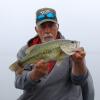Theres many levels of dock fishing, but as this is going to be your first try at it, keep it simple.
Gear: If you have two, you'll want two spinning rods 6' M or MH with a good abrasion resistant line. My choice was always 10lb Trilene XT.
Baits: 1st rod you texas rig something weedless with NO exposed weight. A T-Rig Tube with an internal weight, or T-Rig a worm, lizard, or some other critter bait that you can weigh down with a nail weight. 2nd rod you can T-Rig with a pegged worm weight or a jighead as long as the hook is covered.
Approaching the Dock: As you are new to this, come in slowly from downwind. Try to avoid swinging trolling motor where prop wash is going under your target. If you over shoot, let the wind push you back away from the dock.
Where to fish: 1st cash should be to the outside posts, either on the front, or the downwind side. A simple pitch with no skipping needed. If there is a boat tied off on that side, "carefully" pitch up next to it with 1st rod only. Don't tick off the boat owner by bouncing a 3/8oz bullet weight off his gel coat. On a pontoon boat, you don't want to ring the side of the tubes either. Once you've worked the outside of the dock, try skipping the bait on the 1st rod up under the overhead cover. Keep your rod angle low and try to just hit the water prior to the dock. Low angle means a low skip. Before you leave the dock, go ahead and try skipping the 2nd rod. It will be noisy if you make a bad cast, but hey, you've already worked the dock. If you catch a fish, remember where it was positioned on the dock. Try to establish a pattern with repeated catches to see if a particular spot seems to attract the fish, i.e; shaded side, down wind, upwind, near the end, close to shore, etc., etc..
The Bite: WATCH YOUR LINE! Sometimes you will feel the classic tap, but most times one of two things will happen. Either the fish will start swimming away with the bait, or the bait will stop falling and you see a slight "jump" in the line.
The Hookset and Fight: Normally, set the hook with a low sideways sweeping hookset. If at all possible, keep hauling on the fish until it is out from under the dock where you can fight it away from obstructions. Remember if you've pitched over a rope or some other obstruction that the fish has to come back over it. Think about the odds of getting the fish out of any place you cast, before you cast. One other thing, that works when all else fails. Sometimes you will set the hook into a fish that wedges itself up against something under there where you can't move the fish. At this point, open the bail to give the fish slack. Sometimes they will swim free from this blockage and the fight can start over, sometimes.
Hazards: Besides ticking off a boat or dock owner, plan your casts before you execute. If a dock has ropes, cables, and other assorted junk hanging underneath it, just settle for flipping the outside. Also, if you hang a bait on the dock or a boat, DO NOT attempt to retrieve it by getting out of your boat to get it. Most States call this trespass. You are better off to just clip your line, re-tie and move on.
A Few Extras: Brush Piles. Many docks will have these placed in front of the dock for crappie fishing. Look for signs like rod holders on the dock, an overhead light, or fish feeders. Boat Lifts. Many of these will have a depression in the bottom at the back end of the boat where the owner has powered onto the lift. Ladders. Don't ask, just always fish any ladder.
One last thing. Always respect the dock owners. If they are on the dock, ask if you can fish before you cast, and make a wide swing around anyone fishing from their dock. And stay off of them.
Hey, good luck and have fun. A few good days of dock fishing and you'll be hooked.









